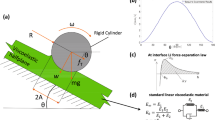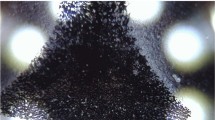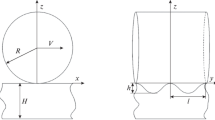Abstract
We study the contact mechanics of a smooth hard cylinder rolling on a flat surface of a linear viscoelastic solid. Using the measured viscoelastic modulus of unfilled and filled (with carbon black) nitrile rubber, we compare numerically exact results for the rolling friction with the prediction of a simple analytical theory. For the unfilled rubber, the two theories agree perfectly while some small difference exists for the filled rubber. The rolling friction coefficient depends nonlinearly on the normal load and the rolling velocity.







Similar content being viewed by others
Notes
It can be easily shown that the discrete formulation of the viscoelastic line contact kernel presents an analytical formulation as it occurs for the elastic case. This largely simplifies the viscoelastic integration.
References
Persson, B.: Sliding Friction: Physical Principles and Applications, 2nd edn. Springer, Heidelberg (2000)
Grosch, K.: The relation between the friction and visco-elastic properties of rubber. Proc. R. Soc. Lond. A Mat. 274, 21–39 (1963)
Persson, B.: Theory of rubber friction and contact mechanics. J. Chem. Phys. 22, 325107 (2010)
Persson, B.: Rubber friction: role of the flash temperature. J. Phys.: Condens. Matter 18, 7789–7823 (2006)
Persson, B., Albohr, O., Tartaglino, U., Volokitin, A., Tosatti, E.: On the nature of surface roughness with application to contact mechanics, sealing, rubber friction and adhesion. J. Phys.: Condens. Matter 17, R1–R62 (2005)
Heinrich, G., Klüppel, M., Vilgis, T.: Evaluation of self-affine surfaces and their implication for frictional dynamics as illustrated with a Rouse material. Comput Theory Polym S 10, 53–61 (2000)
Heinrich, G., Klüppel, M.: Rubber friction, tread deformation and tire traction. Wear 265, 1052–1060 (2008)
Persson, B., Volokitin, A.: Rubber friction on smooth surfaces. Eur. Phys. J. E 21, 69–80 (2006)
Carbone, G., Lorenz, B., Persson, B., Wohlers, A.: Contact mechanics and rubber friction for randomly rough surfaces with anisotropic statistical properties. Eur. Phys. J. E 29, 275–284 (2009)
Persson, B.: On the theory of rubber friction. Surf. Sci. 401, 445–454 (1998)
Le Gal, A., Yang, X., Klüppel, M.: Evaluation of sliding friction and contact mechanics of elastomers based on dynamic-mechanical analysis. J. Chem. Phys. 123, 014704 (2005)
Persson, B.: Theory of powdery rubber wear. J. Phys.: Condens. Matter 21, 485001 (2009)
Mofidi, M., Prakash, B., Persson, B., Albohr, O.: Rubber friction on (apparently) smooth lubricated surfaces. J. Phys. Condens. Mat. 20, 085223 (2008)
Persson, B., Albohr, O., Creton, C., Peveri, V.: Contact area between a viscoelastic solid and a hard, randomly rough, substrate. J. Chem. Phys. 120, 8779–8793 (2004)
Greenwood, J., Johnson, K., Choi, S.-H., Chaudhury, M.: Investigation of adhesion hysteresis between rubber and glass using a pendulum. J. Phys. D: Appl. Phys. 42, 035301 (2009)
She, H., Malotky, D., Chaudhury, M.: Estimation of Adhesion Hysteresis at Polymer/Oxide Interfaces Using Rolling Contact Mechanics. Langmuir 14, 3090–3100 (1998)
Greenwood, J., Tabor, D.: The friction of hard sliders on lubricated rubber: the importance of deformation losses. J. Phys. Soc. 71, 989 (1958)
Greenwood, J.A., Minshall, H., Tabor, D.: Hysteresis losses in rolling and sliding friction. Proc R. Soc. Lond. A Mat. 259, 480–507 (1961)
Tabor, D.: The rolling and skidding of automobile tyres. Phys. Rev. Spec. Top-Ph 29, 301 (1994)
Felhos, D., Xu, D., Schlarb, A., Vradi, K., Goda, T.: Viscoelastic characterization of an EPDM rubber and finite element simulation of its dry rolling friction. Express Polym. Lett. 2, 157–164 (2008)
Hunter, S.: The rolling contact of a rigid cylinder With a viscoelastic half space. J. Appl. Mech. 28, 611–617 (1961)
Goryacheva, I.G.: Contact problem of rolling of a viscoelastic cylinder on a base of the same material. J. Appl. Math. Mech. 37 877–885 (1973)
Panek, C., Kalker, J.: Three-dimensional contact of a rigid roller traversing a viscoelastic half space. IMA. J. Appl. Math. 26, 299–313 (1980)
Vollebregt, E.: User guide for CONTACT, Vollebregt and Kalker’s rolling and sliding contact model. Techical report TR09-03, version 13.1 (2013)
Persson, B.: Rolling friction for hard cylinder and sphere on viscoelastic solid. Eur. Phys. J. E 33, 327–333 (2010)
Carbone, G., Putignano, C.: A novel methodology to predict sliding and rolling friction of viscoelastic materials: theory and experiments. J. Mech. Phys. Solids 61, 1822–1834 (2013)
Persson, B.: Contact mechanics for layered materials with randomly rough surfaces. J. Phys. Condens. Mat. 24, 095008 (2012)
Scaraggi, M., Persson, B.: Theory of viscoelastic lubrication. Tribol Int 72, 118–130 (2014)
Yang, C. Persson, B.: Contact mechanics: contact area and interfacial separation from small contact to full contact. J. Phys. Condens. Mat. 20, 215214 (2008)
Lorenz, B., Pyckhout-Hintzen, W., Persson, B.: Master curve of viscoelastic solid: using causality to determine the optimal shifting procedure, and to test the accuracy of measured data. Polymer 55, 565–571 (2014)
Acknowledgments
We thank K.W. Stöckelhuber and G. Heinrich (Leibniz-Institut für Polymerforschung, Dresden) for supplying the nitrile rubber and B. Lorenz (FZJ) for measuring the viscoelastic modulus. MS acknowledges FZJ for the support and the kind hospitality received during his visit to the PGI-1, where this work has been performed. MS also acknowledges COST Action TD0906 for grants STSM-TD0906-020613-031727 and STSM-TD0906-230413-030252.
Author information
Authors and Affiliations
Corresponding author
Rights and permissions
About this article
Cite this article
Scaraggi, M., Persson, B.N.J. Rolling Friction: Comparison of Analytical Theory with Exact Numerical Results. Tribol Lett 55, 15–21 (2014). https://doi.org/10.1007/s11249-014-0327-y
Received:
Accepted:
Published:
Issue Date:
DOI: https://doi.org/10.1007/s11249-014-0327-y




